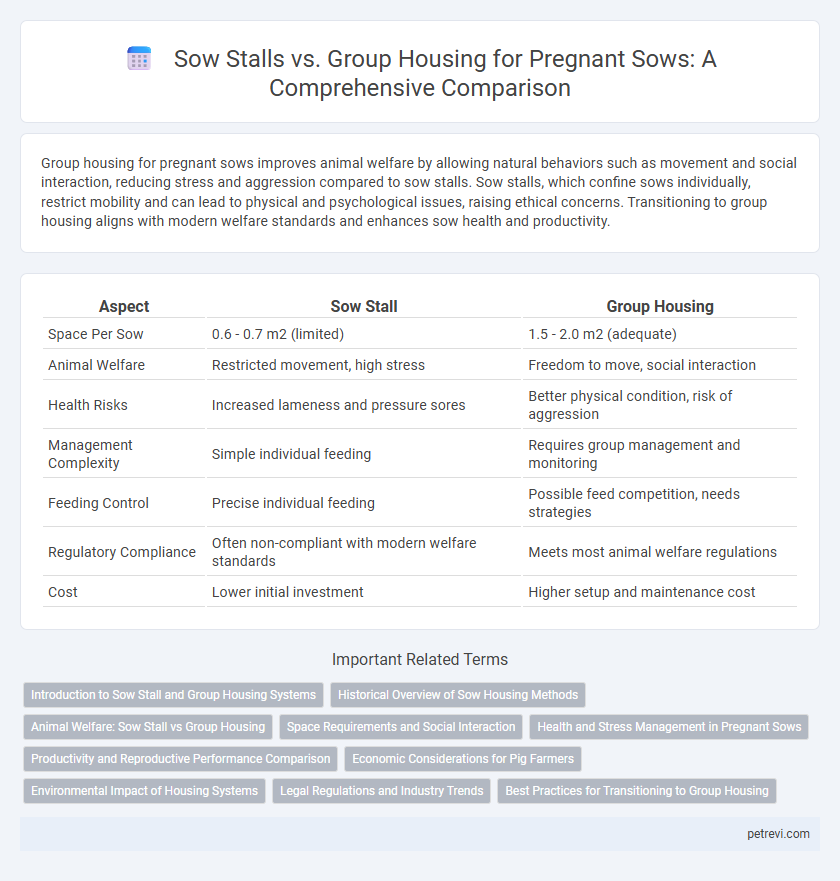Group housing for pregnant sows improves animal welfare by allowing natural behaviors such as movement and social interaction, reducing stress and aggression compared to sow stalls. Sow stalls, which confine sows individually, restrict mobility and can lead to physical and psychological issues, raising ethical concerns. Transitioning to group housing aligns with modern welfare standards and enhances sow health and productivity.
Table of Comparison
| Aspect | Sow Stall | Group Housing |
|---|---|---|
| Space Per Sow | 0.6 - 0.7 m2 (limited) | 1.5 - 2.0 m2 (adequate) |
| Animal Welfare | Restricted movement, high stress | Freedom to move, social interaction |
| Health Risks | Increased lameness and pressure sores | Better physical condition, risk of aggression |
| Management Complexity | Simple individual feeding | Requires group management and monitoring |
| Feeding Control | Precise individual feeding | Possible feed competition, needs strategies |
| Regulatory Compliance | Often non-compliant with modern welfare standards | Meets most animal welfare regulations |
| Cost | Lower initial investment | Higher setup and maintenance cost |
Introduction to Sow Stall and Group Housing Systems
Sow stalls are individual confinement pens measuring approximately 2 meters long and 60 centimeters wide, designed to restrict movement and allow easy feeding and monitoring of pregnant sows. Group housing systems provide larger, communal spaces where sows can move freely, engage in natural behaviors, and establish social hierarchies, improving welfare and reducing stress. Recent EU legislation promotes group housing to enhance sow well-being, citing benefits such as increased physical activity and reduced stereotypic behaviors compared to stall confinement.
Historical Overview of Sow Housing Methods
Sow housing methods have evolved from traditional sow stalls, which confined individual sows in restrictive spaces to control aggression and facilitate management, to group housing systems designed to improve welfare by allowing natural social behaviors. Historically, sow stalls dominated from the 1960s due to their efficiency and ease of individual feeding, but welfare concerns and legislative changes, such as the European Union's 2013 ban on sow stalls during pregnancy, accelerated the shift toward group housing. Modern group housing integrates electronic feeding stations and pen design innovations to balance sow welfare with productivity in commercial pork production.
Animal Welfare: Sow Stall vs Group Housing
Group housing for pregnant sows significantly improves animal welfare by allowing natural behaviors such as rooting, social interaction, and movement, reducing stress and injury risks common in sow stalls. Sow stalls, while space-efficient, severely restrict mobility and often cause physical issues like lameness and pressure sores due to prolonged confinement. Welfare standards increasingly advocate for group housing systems that promote sows' psychological well-being and physical health compared to traditional individual stalls.
Space Requirements and Social Interaction
Group housing for pregnant sows requires significantly more space per animal, typically around 2.5 to 3 square meters, compared to sow stalls which allocate about 0.6 to 0.7 square meters per sow. The increased space in group housing facilitates natural social interactions, allowing sows to exhibit normal behaviors and establish social hierarchies, which reduces stress and aggression. In contrast, sow stalls restrict movement and prevent social contact, leading to behavioral problems and potential welfare concerns.
Health and Stress Management in Pregnant Sows
Group housing for pregnant sows significantly improves health outcomes by promoting natural behaviors and reducing stress hormone levels compared to sow stalls. Studies show that group-housed sows exhibit lower incidence of lameness and higher immune response, enhancing overall well-being. Managing social interactions and providing adequate space in group settings further mitigates aggression and stress, resulting in better reproductive performance.
Productivity and Reproductive Performance Comparison
Group housing for pregnant sows enhances productivity by allowing natural behaviors, reducing stress, and improving overall health, which leads to higher reproductive performance compared to sow stalls. Studies show sows in group housing exhibit increased feed intake and better farrowing rates, resulting in larger litter sizes and higher piglet survival rates. Sow stalls restrict movement, often causing welfare issues that negatively impact hormonal balance and reproductive efficiency, making group housing a more productive system for modern swine production.
Economic Considerations for Pig Farmers
Group housing for pregnant sows can reduce individual feed costs due to competition-driven efficiency and lower labor expenses compared to sow stalls, which require individualized feeding and management. However, initial investment in group housing systems is higher, including costs for pens, flooring, and monitoring technology, impacting short-term financial planning. Long-term economic benefits may arise from improved sow welfare and productivity, potentially leading to increased piglet survival rates and market value.
Environmental Impact of Housing Systems
Group housing for pregnant sows significantly reduces environmental impact by promoting better ammonia and greenhouse gas emissions control compared to sow stalls, which concentrate waste and increase pollution risks. Improved manure management in group systems leads to lower nutrient runoff, thus protecting soil and water quality. Enhanced ventilation and space allowance in group housing further mitigate harmful emissions, contributing to a more sustainable pig farming operation.
Legal Regulations and Industry Trends
Legal regulations increasingly mandate the transition from sow stalls to group housing systems for pregnant sows to improve animal welfare. The European Union's Directive 2008/120/EC requires group housing from four weeks after insemination until one week before farrowing, influencing global industry standards. Major pork-producing countries like Canada and the United States are adopting similar phased bans on sow stalls, reflecting a broader industry trend toward more humane and socially acceptable housing practices.
Best Practices for Transitioning to Group Housing
Transitioning pregnant sows from stall confinement to group housing requires gradual adaptation to minimize stress and aggression, starting with small, stable groups to promote social harmony. Providing ample space, enrichment materials, and consistent feeding routines supports natural behaviors and improves welfare outcomes. Monitoring sow health and behavior closely during the adjustment period ensures early detection of issues and facilitates timely interventions.
Sow stall vs Group housing for Pregnant sows Infographic

 petrevi.com
petrevi.com